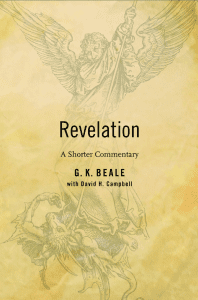How then do we read the Book of Revelation responsibly? This is the concern of this series and Michael Gorman, as a teacher, knows the best way to teach this sort of reading is to give the big picture first. His seven themes (below) are a deconstructive and constructive approach: it deconstructs some popular approaches but constructs an alternative more historical reading of Revelation.
 Gorman, Reading Revelation Responsibly: Uncivil Worship and Witness: Following the Lamb into the New Creation , proposes the following themes as the way to read the Book of Revelation. In other words, if we grasp these themes we will have the handles we need to read the text responsibly. Another way of saying this, though, is that if we read the text from beginning to end, in its context and in the sort of genre it is, we will also come to the same seven themes.
Gorman, Reading Revelation Responsibly: Uncivil Worship and Witness: Following the Lamb into the New Creation , proposes the following themes as the way to read the Book of Revelation. In other words, if we grasp these themes we will have the handles we need to read the text responsibly. Another way of saying this, though, is that if we read the text from beginning to end, in its context and in the sort of genre it is, we will also come to the same seven themes.
What do you think of his seven themes? Anything you would add?
So here they are:
1. The Throne: The Reign of God and the Lamb. God reigns, the Lamb reigns, and God not only will reign but God already reigns. God’s reign and the Lamb’s reign are inseparable, leading to a cruciform vision of reigning.
2. The Reality of Evil and Empire: Evil is real; empire is now. Empire disorders relations with God and others.
3. Temptation to Idolatry and Immorality: Civil religion tempts the church to confuse true worship with false worship. Immorality is ultimately idolatry.4. The Call to Covenant Faithfulness and Resistance. The church is called to resist evil and empire, and this requires discernment and may entail suffering.
5. Worship and an Alternative Vision: to resist the church needs discernment by having an alternative vision, and that vision is the worship of the Lamb. Thus, Gorman’s theme: “uncivil worship.” It is a form of civil disobedience.
6. Faithful Witness: The Pattern of Christ. Jesus is the pattern for how to respond to and live in empire and against evil. This witness is faithful, true, courageous, just, and nonviolent. It is not passive but active and shows up in alternative communities.
7. Imminent Judgment and Salvation/New Creation of God. God is about to judge, to save the faithful and renew the cosmos.
Thus, put together: uncivil worship and witness: following the Lamb out of fallen Babylon into the new creation.
I will now add his five alternative reading strategies:
1. Recognize that the central image is the Lamb that was slaughtered.
2. Remember the Book was written in the 1st Century for 1st Century Christians using 1st Century literary strategies.
3. Abandon linear approaches to the Book as if it were history written in advance. Focus on analogy rather than correlation.
4. Focus on the Book’s call to worship and discipleship.
5. Place the images of death and destruction within the framework of hope.











